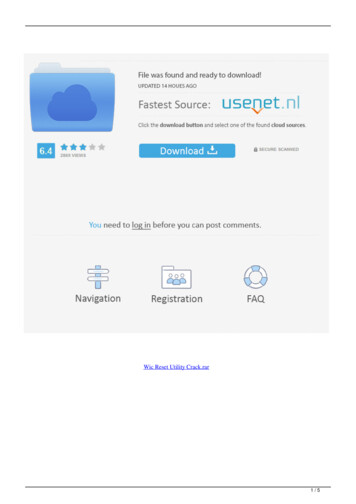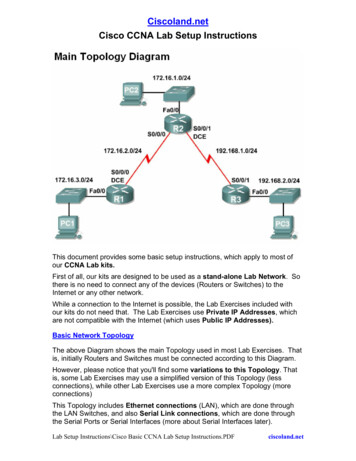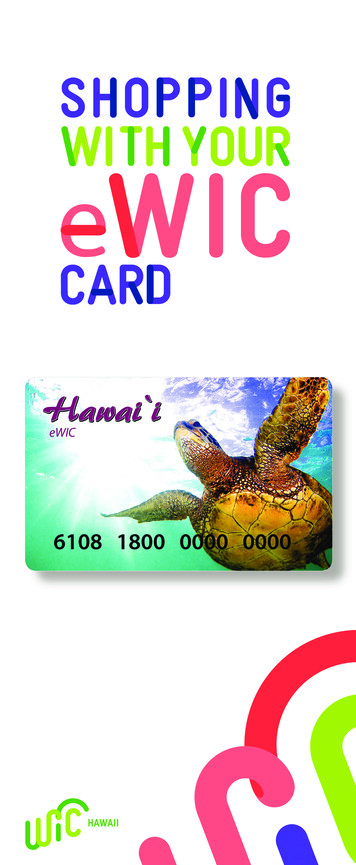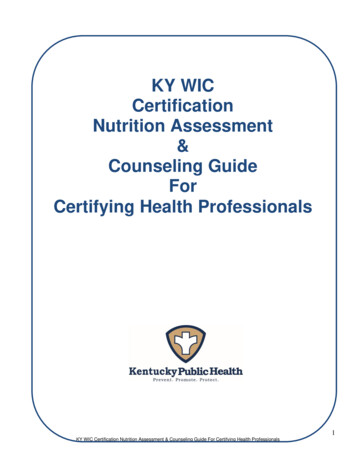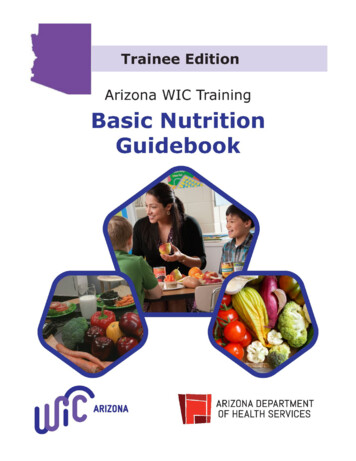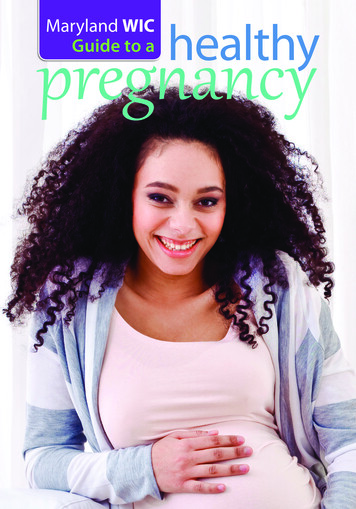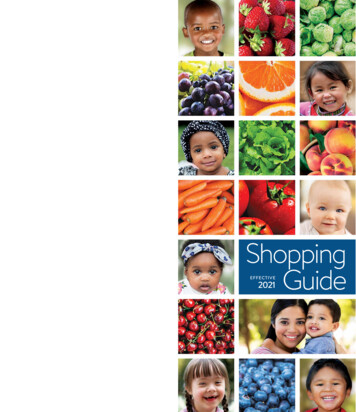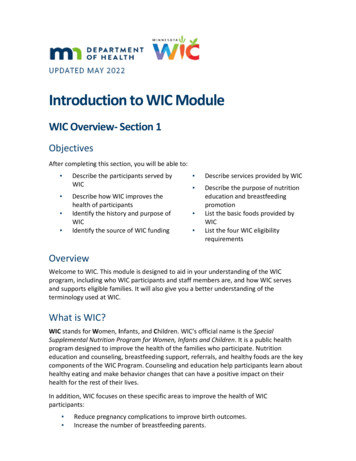
Transcription
UPDATED MAY 2022Introduction to WIC ModuleWIC Overview- Section 1ObjectivesAfter completing this section, you will be able to: Describe the participants served byWICDescribe how WIC improves thehealth of participantsIdentify the history and purpose ofWICIdentify the source of WIC funding Describe services provided by WIC Describe the purpose of nutritioneducation and breastfeedingpromotionList the basic foods provided byWICList the four WIC eligibilityrequirements OverviewWelcome to WIC. This module is designed to aid in your understanding of the WICprogram, including who WIC participants and staff members are, and how WIC servesand supports eligible families. It will also give you a better understanding of theterminology used at WIC.What is WIC?WIC stands for Women, Infants, and Children. WIC’s official name is the SpecialSupplemental Nutrition Program for Women, Infants and Children. It is a public healthprogram designed to improve the health of the families who participate. Nutritioneducation and counseling, breastfeeding support, referrals, and healthy foods are the keycomponents of the WIC Program. Counseling and education help participants learn abouthealthy eating and make behavior changes that can have a positive impact on theirhealth for the rest of their lives.In addition, WIC focuses on these specific areas to improve the health of WICparticipants: Reduce pregnancy complications to improve birth outcomes.Increase the number of breastfeeding parents.
INTRODUCTION TO WIC MODULE Increase breastfeeding frequency and duration.Reduce incidence of iron-deficiency anemia.Decrease the number of low birth weight and premature infants.Improve growth and development of young children.Who is Eligible for WIC?To receive WIC services, applicants must meet four eligibility criteria:1.Live in Minnesota. 2.WIC services are available throughout Minnesota.Most participants receive WIC services in their home county but may receiveservices at any WIC agency or clinic of their choice. (e.g., in the area wherethey work).Be in a category served by WIC. PregnantBreastfeeding with an infant under 12 months of ageNon-breastfeeding up to 6 months postpartumWith pregnancy loss up to 6 months postpartumInfant under 12 months of ageChild 1 to 5 years of ageNote: Father/co-parent, custodial grandparents, foster parents, or other guardians mayapply for WIC for their children.3.Have an income within the WIC Income Guidelines.Current WIC Income Guidelines and adjunctive eligibilities are posted on theWIC website. (You will learn more about income eligibility later).4.Have a nutrition risk – a health condition or nutrition need that can be helpedwith nutritious WIC foods and nutrition education. Some examples include: Anemia (low blood iron)Poor growthHealth conditions like diabetes or high blood pressureFood allergiesMedical problems like hepatitis, cancer and eating disordersInappropriate nutrition practicesFailure to meet dietary guidelines2
INTRODUCTION TO WIC MODULEWhat Services Does WIC Provide?Nutrition EducationWhen families have nutritious food and practice better eating habits, they are healthier. WICoffers nutrition education to all WIC participants and their families. Through WIC nutritioneducation, families learn to make healthful food and lifestyle choices. WIC nutrition educationis participant-centered, designed to meet the needs and interest of each participant.Breast/Chestfeeding Education and SupportBreastfeeding is the healthiest feeding choice for both mother and infant. One of WIC’s roles is topromote and support breastfeeding.Examples include: Provide education about breast/chestfeeding, during pregnancy and after delivery.Train all WIC Competent Professional Authority (CPA) staff and breastfeeding peercounselors to help with breast/chestfeeding questions and concerns.Participate in community efforts to support breast/chestfeeding.Provide additional food to those who are fully breastfeeding to meet their increasednutrition needs.Provide breast pumps to those who need to pump their milk and don’t have anothersource for getting a breast pump with no cost.All employees in WIC have a role in breastfeeding promotion. You will learn more about your rolein the WIC training module on breastfeeding.Healthy FoodsAn important benefit of WIC is the nutritious foods available to participants. WIC givesparticipants special food benefit cards to buy nutritious foods at WIC authorized stores. Eachparticipant receives food benefits for each month they are enrolled in WIC. The foods that WICprovides help meet the special nutrition needs of pregnant and breastfeeding participants and togrowing children. WIC foods are high in protein, calcium, iron, and vitamins. The foods WICprovides are meant to supplement the participant’s diet; WIC does not provide all the food andnutrients that a participant needs. The foods each WIC participant receives will vary, dependingon their “category” (e.g., pregnant, breastfeeding, etc.) and their particular nutritional need.3
INTRODUCTION TO WIC MODULEWIC FoodsWhole Grains: Brown Rice, Oatmeal,Bread, Pasta and TortillasFruits and Vegetables100% JuiceCanned Fish – For Fully Breastfeeding OnlyMilk, Cheese, Eggs, YogurtCanned Beans, Dry Beans, Peas, Lentils, andPeanut ButterTofu and Soy BeverageCold and Hot CerealsInfant Foods: Cereals, Vegetables and Fruits,Meats (for fully breastfed infants), andFormula (if needed)4
INTRODUCTION TO WIC MODULEReferrals to Other Health and Social Service ProgramsPartnerships with other public health and social service programs are a key to WIC’ssuccess. WIC encourages all participants to receive complete health care.WIC refers participants to health care services such as: Prenatal care Well-childcare Family planning ImmunizationsBreastfeeding counselorsCommunity health nursesDrug and alcohol counselingMental health clinicsWIC also refers participants to social service programs such as: Public assistance Supplemental Nutrition Domestic violence programsAssistance Program (SNAP) Head Start Food shelves Parenting classes Emergency shelters and housingIf a participant does not currently receive Medical Assistance or does not have adequatehealth insurance coverage, WIC refers the participant to the Medical Assistance program.WIC also refers participants who might be behind on immunizations to their health careprovider.Your local WIC agency may have local organizations that they also refer participants tofor help. You will learn more about your local agency’s specific referral resources later inyour training.The WIC Program is committed to serving all eligible participants. WIC makes availablebilingual staff or interpreters and materials in other languages and formats when needed.Is WIC Effective?Since the WIC Program began in 1974, it has gained a reputation for being one of thepremiere public health programs. WIC improves the health of nutritionally at-risk women,infants, and children, and promotes positive lifestyle choices that lead to lifelong health.Studies have shown that the WIC program is cost-effective in protecting or improving thehealth and nutrition status of low-income women, infants, and children. See About WICHow WIC Helps.Pregnant women who participate in WIC: Eat more foods rich in key nutrients needed for healthy fetal development (i.e., vitaminsA and C, and iron). See their health care provider earlier in their pregnancy. Are more likely to deliver full-term babies, with healthy birth weights.5
INTRODUCTION TO WIC MODULEInfants, whose mothers participated in WIC: Are born with fewer health problems.Children who participate in WIC are more likely to: Eat foods rich in vitamin A, vitamin C and iron. Have healthy blood iron levels, important for growth and development. See a doctor regularly for check-ups & get their immunizations on time.Minnesota WIC Health OutcomesFor information on how WIC has helped improve the health of women, infants andchildren in Minnesota, refer to the most recent Minnesota WIC Facts and other healthoutcomes data found on the WIC Reports and Data section of the Minnesota Women,Infant, and Children (WIC) website. It has been documented in government and universityresearch that WIC saves health care dollars. USDA Food and Nutrition Services (FNS)reports that WIC Helps; for every dollar spent by WIC, up to three dollars in subsequenthealth care costs are saved!Who Funds and Administers the WIC Program?The WIC Program is federally funded by the US Department of Agriculture (USDA). Thefederal funds are given as a grant to state WIC programs to administer the WIC programlocally. The Minnesota State WIC office, located in St. Paul, administers grants to local WICPrograms throughout the state to provide WIC services. The State WIC agency isresponsible for ensuring that local agency WIC programs comply with federal regulationsand state WIC policies and procedures, and that they provide quality nutrition services.The State WIC agency also provides technical assistance and program support to all localagencies.6
INTRODUCTION TO WIC MODULEPractice Activity - A:1. Review the following WIC brochures and video. Highlight, underline or take note ofthe information that will be most helpful to share with new participants. Welcome to WIC BrochureWelcome to Minnesota WIC Video2. Go to the Minnesota Women, Infants & Children (WIC) website. From the menu on theleft of the webpage, click on “Local Agencies”. Investigate the resources available inthis tab. Where would you look for information about upcoming training opportunities?Skill Check - #11. What are the four eligibility criteria for participating in WIC?2. What four services does WIC provide?3. Where does the money for WIC services come from?7
INTRODUCTION TO WIC MODULEWho Works at WIC- Section 2ObjectivesAfter completing this section, you will be able to: Briefly describe the role of each member of your WIC staff.Identify your responsibilities in WIC.Describe how the state WIC agency helps local agencies.OverviewPeople with a variety of training backgrounds and skills work together to provide WIC services. All localagencies have a WIC Coordinator and Breastfeeding Coordinator who oversee the nutrition andbreastfeeding services in their agency. Every agency also has Competent Professional Authorities (CPAs)who work with participants and provide the nutrition services. Each agency has a Local SystemsAdministrator (LSA), and some agencies employ a clerk. The number of WIC staff usually depends on thenumber of WIC participants the agency serves.In some clinics, one person may function in more than one role. For example, the WIC Coordinator mightalso be the Breastfeeding Coordinator. Some agencies have only one or two people working in the WICProgram. Some agencies designate one or more CPAs to serve all the agency’s “high risk” participants. Afew WIC agencies have breastfeeding peer counselors. As you read the following descriptions of WICroles, think about your role and where you fit in.Who Works in Your WIC Clinic?Clerk/ReceptionistA WIC applicant’s first contact with WIC is sometimes with the Clerk or Receptionist. The WIC Clerk’sresponsibilities might include: Screen families for residency, identity,and income eligibilitySchedule and reschedule appointmentsPromote breastfeeding andnutrition education8Issue food benefitsIssue the WIC cardAnswer phone calls
INTRODUCTION TO WIC MODULECompetent Professional AuthorityCompetent Professional Authority (CPA) is the “official” name for WIC staff who enroll WICapplicants/participants to receive appropriate WIC benefits. They conduct the nutrition assessment andprovide nutrition education services. The enrollment process is called certification. The CPA’sresponsibilities might include: Determine whether an applicantqualifies for WICTake height and weight measurementsTest blood iron by a finger-stickAssess and document health andnutrition riskProvide nutrition education andcounseling Assist the participant in setting nutritiongoalsProvide breastfeeding education andsupportPrescribe a food benefit packageMake appropriate referralsCategories of CPAsProfessional CPAA credentialed nutrition professional such as Registered Dietitian, or Licensed Dietitian/ LicensedNutritionist. Other credentialed individuals may work in WIC such as public health nurses. Aprofessional CPA may have a bachelor’s or master’s degree in a health profession, such as nutrition,nursing, or trained as a dietary technician.Para-Professional CPAA para-professional CPA is employed by a local agency to provide nutrition services in anotherlanguage or cultural context. They must meet the educational requirements for paraprofessionalCPA staff as outlined in the Minnesota Operations Manual (MOM) Chapter 4: Local AgencyStaffing. They may speak another language and/or be of another cultural group served by the localagency. The individual is trained by WIC to certify and counsel participants. The para-professionalCPA is supervised by a nutrition professional and serves low-risk participants only.High Risk CPAEach local WIC agency will have on staff (or by contract) qualified nutrition professionals to providenutrition services to high-risk participants. These qualified nutrition professionals may be referredto as “High Risk CPAs”. When a CPA with this qualification is not available, a CPA who is a registerednurse, registered dietetic technician, etc. maybe used after consultation with the State NutritionConsultant.The high-risk CPA’s responsibilities might include: Enroll and counsel high risk participantsAddress more complex nutrition conditions and issuesWrite nutrition care plans for high-risk participantsTrain other agency CPAs on nutrition topics9
INTRODUCTION TO WIC MODULENOTE: Refer to MOM Chapter 4: Local Agency Staffing, in the Minnesota Operations Manual for moreinformation on the requirements for CPAs.Breastfeeding CoordinatorEach local agency has a Breastfeeding Coordinator. The Breastfeeding Coordinator usually has advancedtraining in lactation (breastfeeding) counseling, education, and support. The Breastfeeding Coordinator’sresponsibilities might include: Coordinate breastfeeding promotion activities.Answer breastfeeding questions from participants and agency staff.Assist participants who are having problems breastfeeding.Create a clinic environment that supports breastfeeding.Breastfeeding Peer CounselorA Breastfeeding Peer Counselor provides basic breastfeeding information and encouragement to WICpregnant and breastfeeding mothers. She is a mother who has personal experience with breastfeedingand is participating (or has participated) in the WIC Program. The Breastfeeding Peer Counselor Program isnot available at every local agency.Note: Breastfeeding support is the responsibility of all WIC staff. All CPAs are trained in breastfeedingeducation and support and talk with participants about breastfeeding as part of WIC services.WIC CoordinatorThe WIC Coordinator is the leader of the WIC agency. In some agencies, the WIC Coordinator is also theBreastfeeding Coordinator. The WIC Coordinator’s responsibilities might include: Plan and oversee WIC nutrition services.Train and supervise WIC staff.Manage the agency’s WIC caseload (i.e., # participants receiving WIC).Communicate with State staff and disseminate information from the state WIC program to thelocal agency’s staff.Make sure that program regulations are followed.Make decisions and answer questions.Manage WIC clinic flow and the appointment schedule to assure clinic runs smoothly.Ensure that all applicants/participants are treated fairly and not discriminated against based onrace, color, national origin, age, sex, or disability.Local Systems Administrator (LSA)The WIC Program uses an electronic data system to collect and store information about WIC participants.The LSA is responsible for conducting data system administrative functions in the WIC system.10
INTRODUCTION TO WIC MODULEWho Works at the State WIC Office?The state WIC agency has a wide range of people on staff with varying backgrounds and expertise. Someareas of expertise include: Outreach and Referrals Nutrition WIC Policy Breastfeeding Information System Clinic Management Reports and Data Analysis Finance/Budgets Vendor (Store) Management Grant Management Food Package and Shopping TrainingEvery local agency has a State WIC Consultant assigned to them by region. This is your agency’s primarycontact for questions. If your State WIC Consultant doesn’t know the answer to your question, they willrefer you to other State WIC staff with expertise in that area or will research out an answer for you. Inmost agencies, the WIC Coordinator will be the main person who will contact the State WIC Consultant.The State Staff Directory is located on the WIC website.The state WIC office sends out a weekly email communication called the WIC Wednesday Update. Itprovides information on policy and procedure updates, new WIC activities, training opportunities, WIC jobopenings around the state, etc. It is also posted on the Local Agency section of the WIC website underFinance & Program Management. Staff may sign up to receive the Wednesday Update by contacting theirState WIC Consultant.11
INTRODUCTION TO WIC MODULEPractice Activity - B Make a list of staff in your clinic and note their responsibilities. Work together with acoworker or your supervisor on this activity. Do you have someone listed for all thejobs you read about in this section? Talk to your supervisor about your role in WIC. Where do you fit into the WIC Team? If you work in a WIC program that is part of a larger organization, talk to yoursupervisor about how WIC fits into the organization. Take note of people in the largerorganization whom you may need to contact. Ask your WIC supervisor for the name and contact information for your State WICConsultant. Talk with your supervisor about your WIC role and in which circumstancesyou might need to contact the State WIC staff.12
INTRODUCTION TO WICSkill Check- #21.Who is your WIC clinic receptionist or clerk?2.Who in your clinic would answer questions about breastfeeding?3.Who in your clinic would answer questions about a nutrition issue?4.Who in your clinic would answer questions about the WIC Information System?5.Who in your clinic would answer questions about high-risk nutrition issues?6.When should you contact the State WIC staff? How would you locate their phone number andemail?13
INTRODUCTION TO WICConfidentiality- Section 3ObjectivesAfter completing this section, you will be able to: Follow procedures for protecting the confidentiality of WIC information.OverviewAs a WIC employee, you will regularly have access to participants’ personal information. Keeping theinformation private and confidential is a critical part of your job.ConfidentialityThere are two key points to confidentiality in WIC.1.Do not release information from a participant’s record without that person’s consent.2.Always maintain WIC participants’ privacy.This is best accomplished by: Providing private space for WIC assessments & counseling.Protecting the computer screen from the view of others.Ensuring the protection and security of WIC data and equipment.For more information on privacy and confidentiality, read MOM Section 1.7, Data Privacy , andMOM Section 5.9, Clinic Environment, in the Minnesota Operations Manual (MOM). Read anyother agency policies on confidentiality as requested by your supervisor.Skills Check - #31.What are three examples of a breach in confidentiality?2.How will you keep the information on your computer private?Final Skills CheckAnswer True (T) or False (F) for each of the statements below:1.WIC helps improve the health of participants by reducing iron deficiency anemia.2.WIC’s official name is the Special Supplemental Food Program for Women, Infantsand Children.14
INTRODUCTION TO WIC3.A woman must be pregnant or breastfeeding to qualify for the WIC Program.4.A medical condition, such as high blood pressure, would qualify an applicant for anutrition risk.5.Foster parents may apply for WIC for their foster children.6.Breastfeeding education and support is one of the services provided by WIC.7.WIC is required to refer participants not receiving Medical Assistance to the program.8.There have been no studies that demonstrate the cost effectiveness of the WICProgram.9.WIC is federally funded by the United States Department of Health and HumanServices.10.Only the Breastfeeding Coordinator can counsel a pregnant woman on what toexpect with breastfeeding.11.Not all local agencies have Breastfeeding Peer Counselors.12.WIC Staff must always protect the privacy of participants.Training Module Answer KeysDictionary of WIC LingoAdditional Nutrition Education Visit (Nutrition “Follow-up”): Nutrition education visitsoccur at least quarterly, and at some point, between a cert/recert and the midcert appointment.Depending on your agency, these may be completed by appointment, over video or phone, orwhen a participant walks into the clinic. WIC staff may discuss a previously set nutrition goal oranother topic of interest to the participant. It is also an opportunity to provide anticipatoryguidance, especially for infants and toddlers. Pregnancy follow up appointments should includeconversations about breastfeeding, baby behavior or other pregnancy concerns. Participantsreceive their next set(s) of food benefits at this visit.NOTE: Avoid calling this visit a “Benefit Pickup”, because this implies that the participant will only berenewing their benefits and will not be visiting with a CPA.15
INTRODUCTION TO WICAdjunctive Eligibility: Automatically income eligible for WIC if the participant is activelyparticipating in other specified programs that have already performed an income eligibility. Thisallows WIC to not have to re-determine income.Certification (cert): Initial appointment to determine if someone meets eligibility requirements toparticipate in the WIC program. This term should be referred to as “enroll” rather than “cert orcertify” when speaking to participants. This appointment involves verification of income andresidency, a complete health and nutrition assessment, nutrition counseling, referrals, and foodpackage assignment with education on shopping for WIC foods.Certification Guided Script (CGS): The computer procedure that staff go through during acertification or recertification appointment to determine a participant’s eligibility for the WICProgram. It involves screening for demographics/income eligibility, health screening, dietaryassessment, risk code assignment, nutrition education and benefit issuance.Competent Professional Authority (CPA): The official name for staff who have met theeducation requirements or training to enroll or certify and counsel WIC participants.Education Choice: WIC Education Choice, expands the choices participants have on how theywould like to receive additional nutrition education. Once a certification or recert has beencompleted, participants can choose to receive additional nutrition education in-person, online,or by phone at their next WIC contact. Education choice is not a “shortcut” for staff but canexpand opportunities to provide nutrition education and breastfeeding support to participants.FDTU/LDTU: Acronyms referring to the first-day-to-use and last-day-to-use of food benefits. Thisdate is important since more than one month of food benefits is usually issued at a time so aparticipant must wait until the FDTU before using the new benefits.Food Package: The amount and type of food a participant receives from WIC each month. Mostfoods are automatically assigned, some a participant must choose.High Risk CPA/Nutrition Specialist: Designated staff person(s) who are nutrition professionalswho have been trained to see High Risk participants. These appointments are typicallyscheduled sometime between the Cert/Recert and the Midcert, and count as the additionalnutrition education visit. High risk situations should be addressed as soon as possible; thisappointment may be scheduled the next month after a certification or recert (In this case, onemonth of food benefits would be issued).Household ID: An ID number that is assigned to everyone in a household that is receives WICservices. This number links multiple individuals in the same family together. This number can bechanged for an individual, if there are custody changes or if for some other reason an individualis removed from a family.INCP: Individual Nutrition Care Plan. A care plan written specifically for high-risk individuals thatoutlines both the steps to resolve the high-risk condition as well as a plan for follow-up.16
INTRODUCTION TO WICInitial Contact: A processing standard that occurs when a participant is first entered into theInformation System, returns for a new pregnancy or after a lapse in WIC service. This usuallyhappens when the participant calls to schedule an appointment or walks into the clinic torequest one. An appointment should not be scheduled until an initial contact is completed aspart of the required processing standards for WIC participants.Mentor: Refers to a fellow coworker trained in mentoring and works with staff individually to helpthem develop and strengthen their skills. Some agencies may have mentors for new staff, PCS,or for other reasons.Midcertification (midcert.): Appointment scheduled between recertifications. Midcerts differfrom recerts in that they do not require income and residency verification and the nutritionassessment has a different focus. Risk code assignment is not required during the midcertappointment. Infant Midcert.: A WIC visit for babies at 9-10 months of age, scheduled when the baby isexactly 9 months or older. Length, weight, and hemoglobin are checked. Nutritionassessment and education is provided.Breastfeeding Midcert.: A WIC visit for breastfeeding women, either scheduled around 6months postpartum, or scheduled at the same time as the infant midcert. Weight is checkedand hemoglobin (if needed). Nutrition assessment and education are provided.Child Midcert.: WIC visit for children about 6 months into the certification period. Heightand weight is checked along with hemoglobin (if needed). Nutrition assessment andeducation are provided.Mid-certification Assessment Guided Script: The computer procedure staff go through inorder to complete a midcert. It involves screens for each step of the assessment. Only theanthropometric field is required in this guided script, however the state requires nutritionassessment and nutrition education.Minnesota Operations Manual (MOM): This is the policy and procedures manual thatcontains all the rules and regulations for the Minnesota WIC program. These policies are basedon federal regulations and are approved by USDA. MOM is posted on the Minnesota WICwebsite under Information for Local Agencies/Finance & Program Management.Participant Centered Services (PCS): The approach that is taken to interact with families in allaspects of our work. We focus on making our clinics a welcoming place for families andproviding supportive customer service, including appointment times that meet a participant’sneeds, nutrition education tailored to each family member, and individualized goal setting.Participant Folder: The location in the WIC Information System where all the information about aparticipant is stored. The folder differs from the CGS in several ways. There are things that theWIC Information System allows in the folder that it does not allow in the CGS and vice versa. Ifyou have multiple folders and/or Guided Scripts open at the same time, it is important that youknow which one you are working in.17
INTRODUCTION TO WICPrescreening: Prescreening is done when entering a new applicant in the Information System. It isused to determine a participant’s potential eligibility for WIC. Prescreening does not guaranteeeligibility; that is determined at the WIC appointment. Prescreening is only done once, even if aparticipant is not enrolled in WIC for a period of time. Once they are in the system and have astate ID number, they never need to be prescreened again.Proxy: A person 16 years or older listed in the WIC Information System as an alternate. This personhas been given permission from the participant to represent the participant at certificationappointments and nutrition education contacts and purchase the food benefits at the store asnecessary.Recertification (recert.): Appointment to reevaluate eligibility for the WIC program and provideadditional nutrition assessment, education, and referrals. Recertification generally occurs every12 months, with some exceptions.Separation of Duties (SOD): Refers to the WIC federal regulation in which the same staff personcannot determine both income eligibility and medical or nutrition risk eligibility through thecertification process. These two eligibility determinations must be done by two separate staffmembers.SOAP: This is an acronym for a medical documentation format for recording information during anutrition assessment and education session. (S Subjective information O Objectiveinformation A Assessment P Plan).State WIC ID: Individual ID number assigned to every individual as soon as an individual isprescreened in the WIC Information System. This number is unique to each individual and neverchanges.Verification of Certification (VOC): This is the name of the form that contains pertinentinformation needed in order to transfer in a person, who is within a certification period inanother state, to Minnesota WIC. A copy of this form containing the necessary information isprovided by Minnesota WIC to participants who are moving out of Minnesota to another Stateas well.WIC Card (eWIC): A magnetic swipe card that participants use to p
WIC Foods . Fruits and Vegetables . 100% Juice . Milk, Cheese, Eggs, Yogurt . Cold and Hot Cereals . Canned Fish - For Fully Breastfeeding Only. Canned Beans, Dry Beans, Peas, Lentils, and Peanut Butter Tofu and Soy Beverage . Infant Foods: Cereals, Vegetables and Fruits, Meats (for fully breastfed infants), and Formula (if needed)
